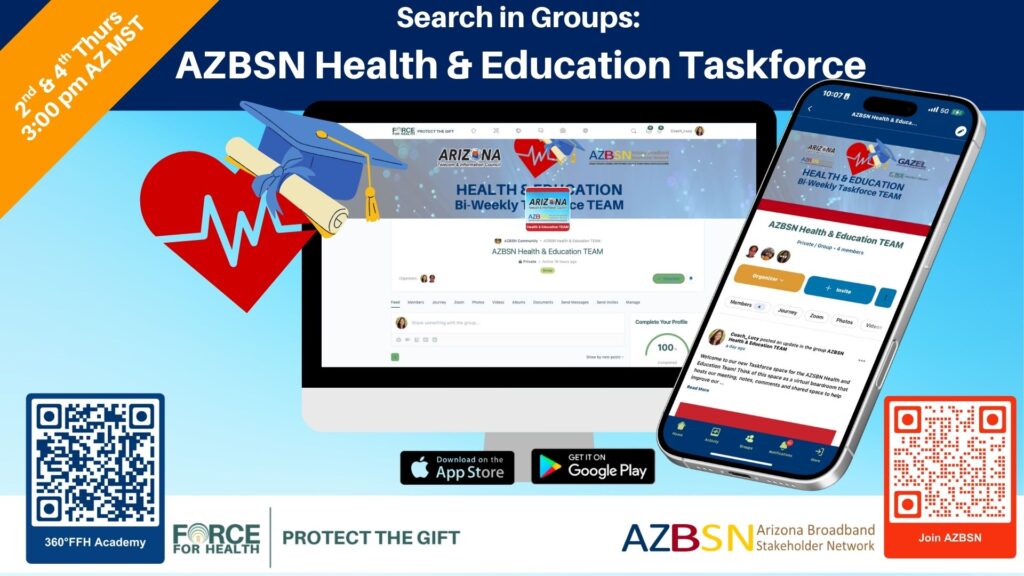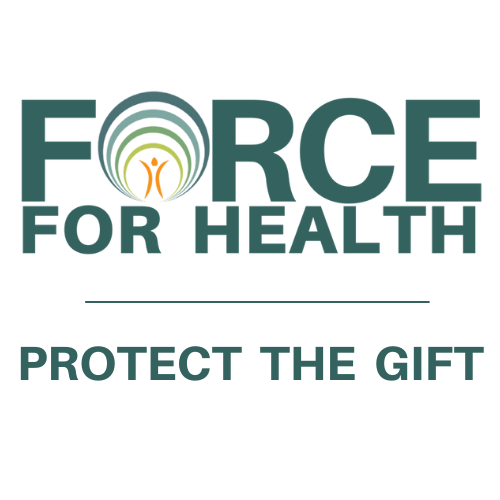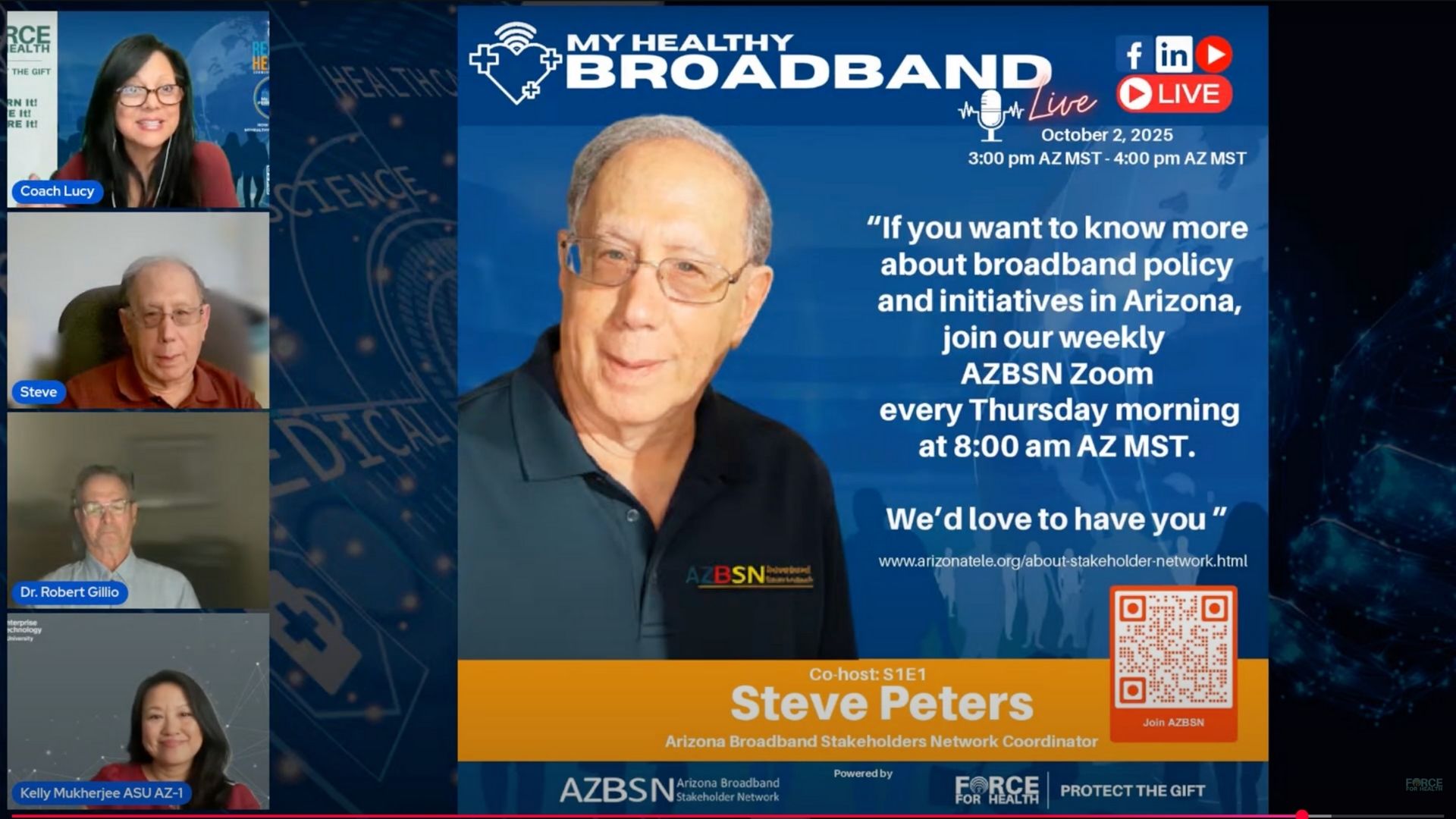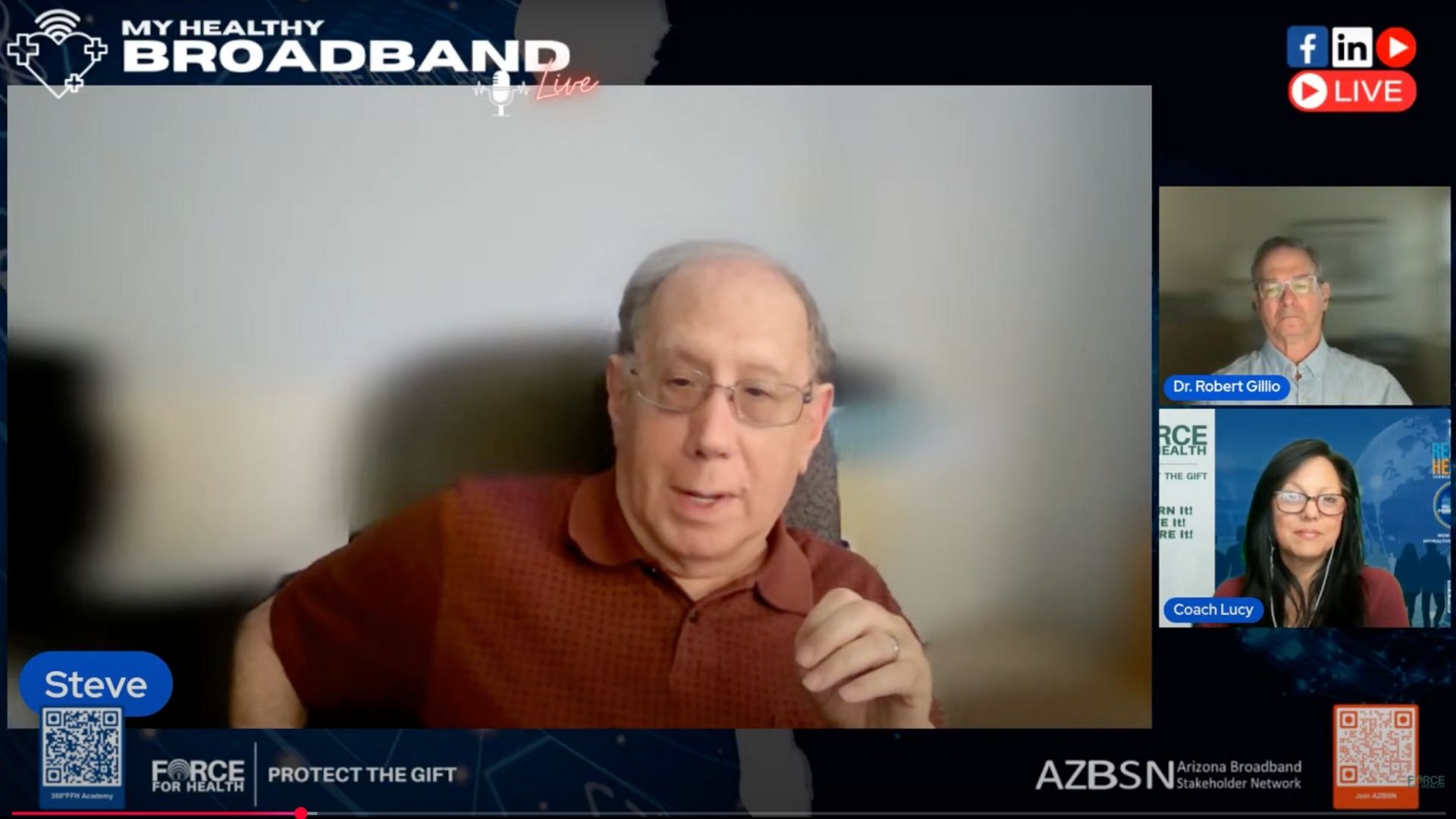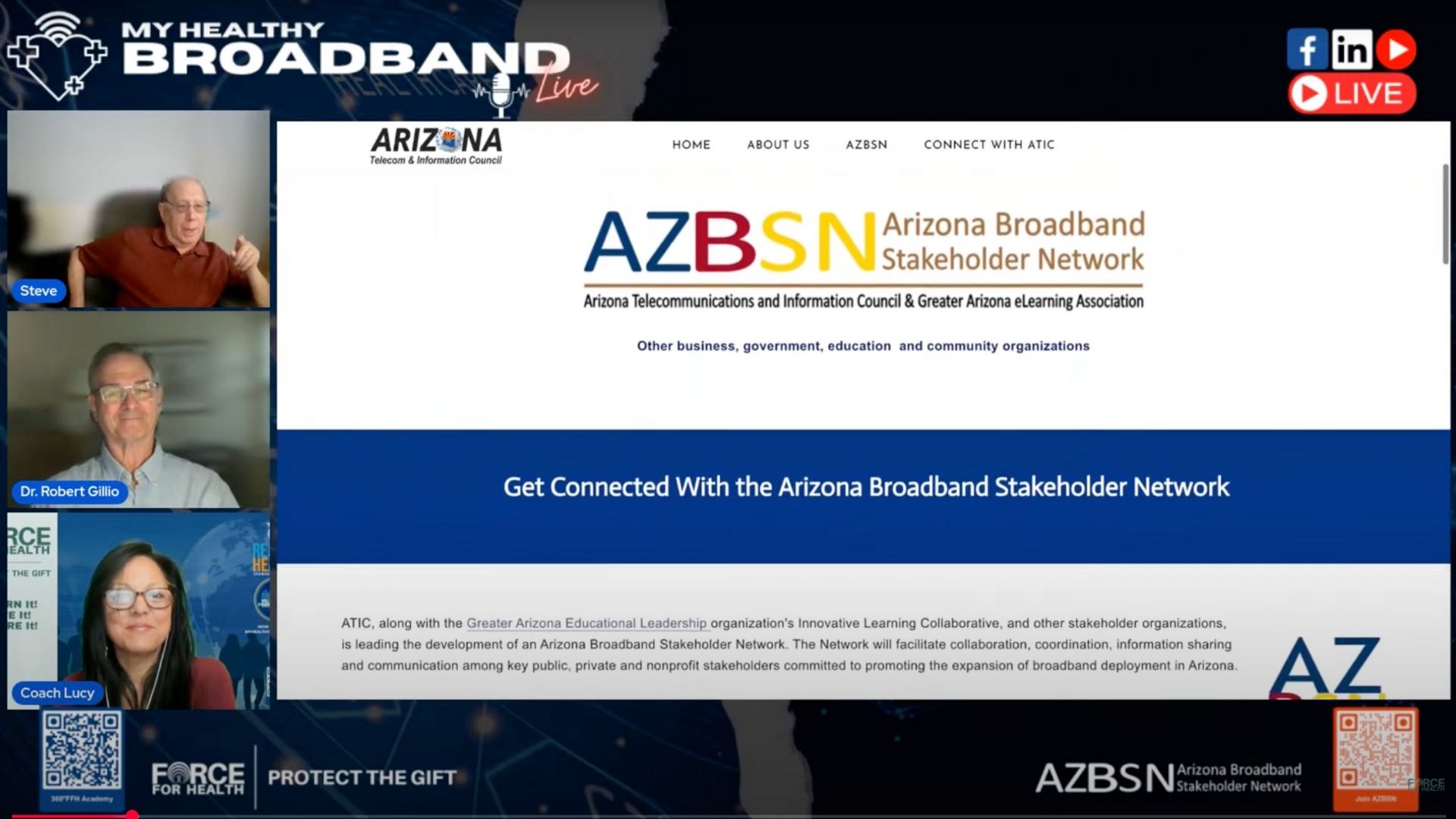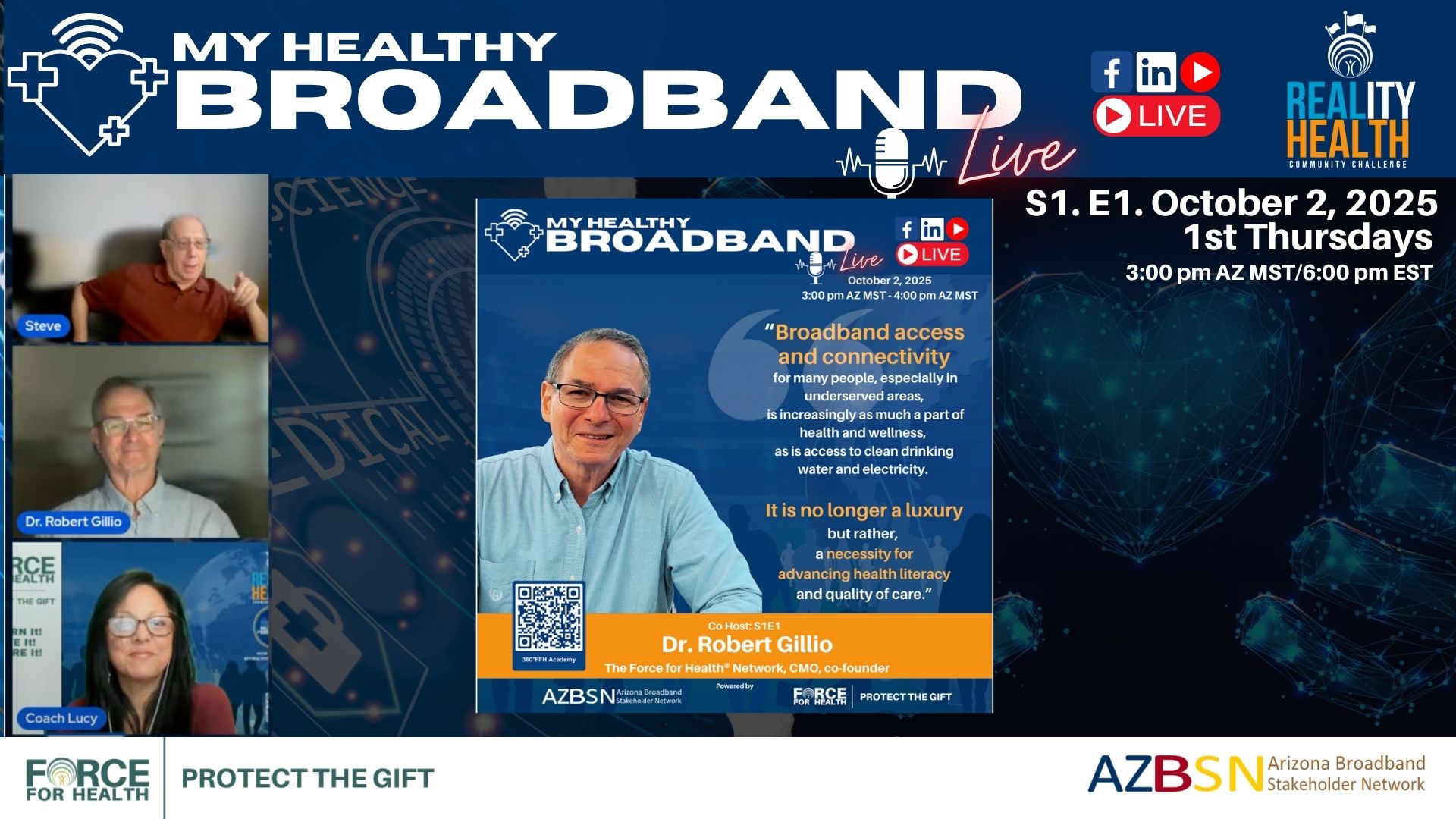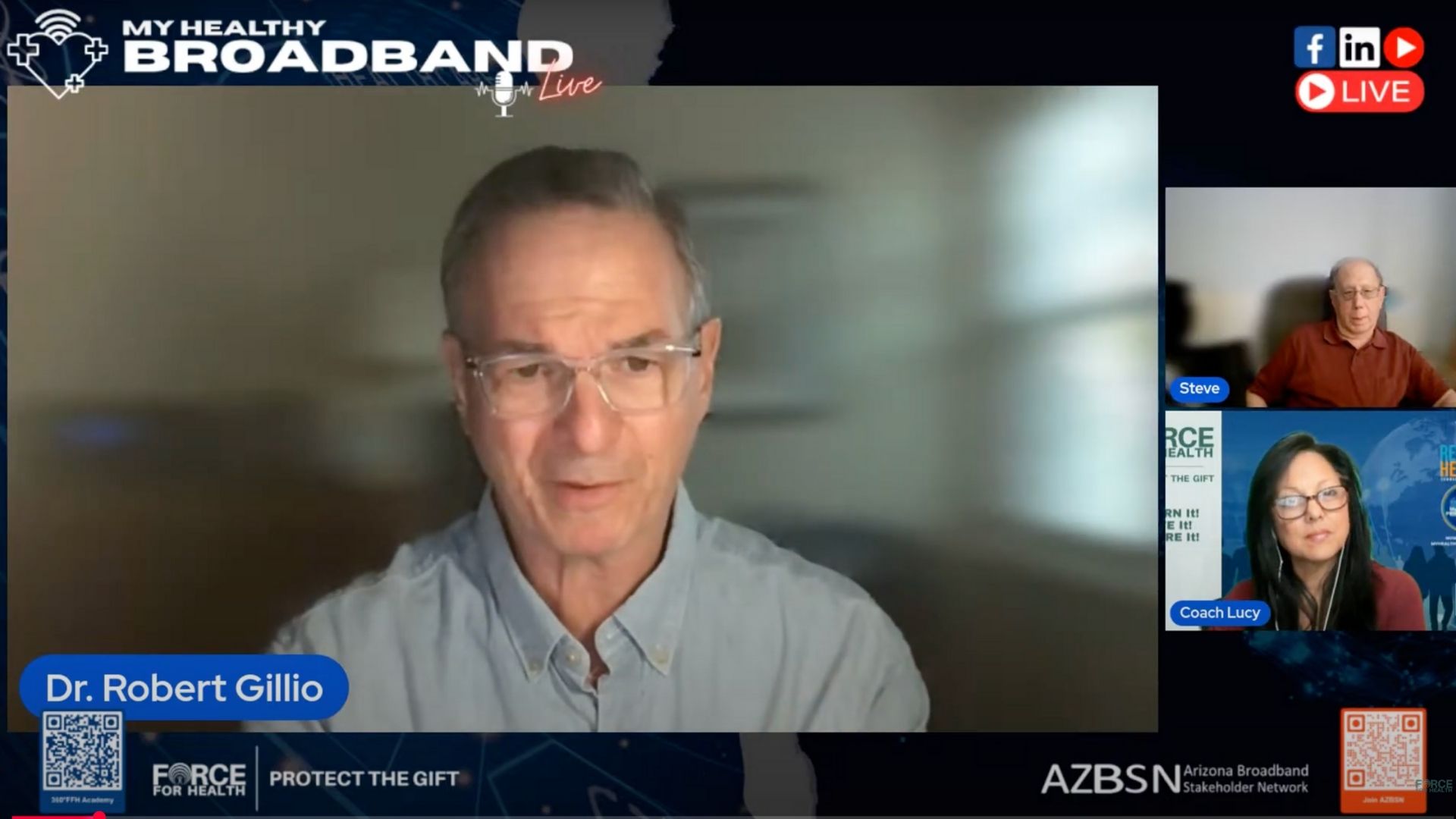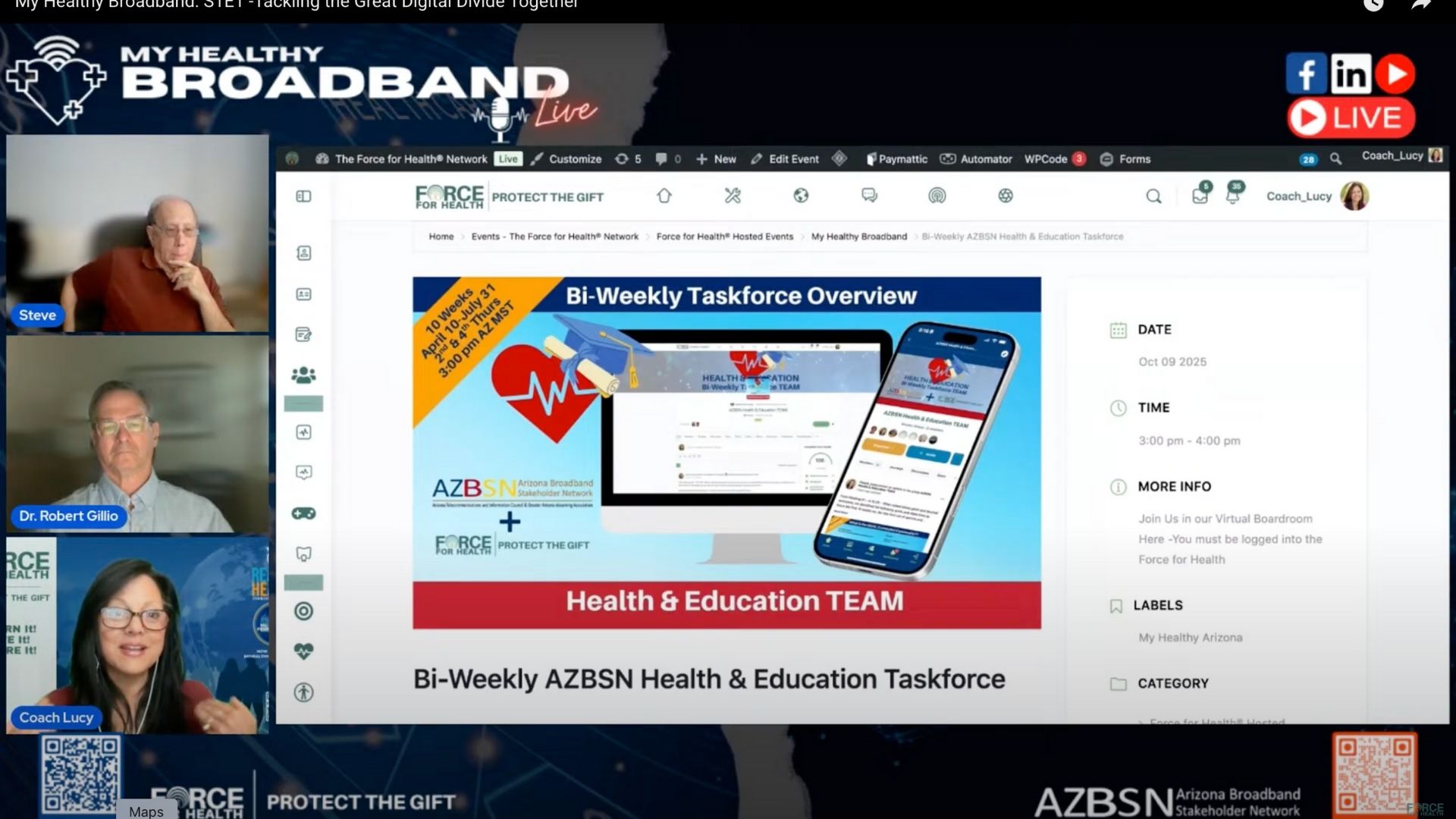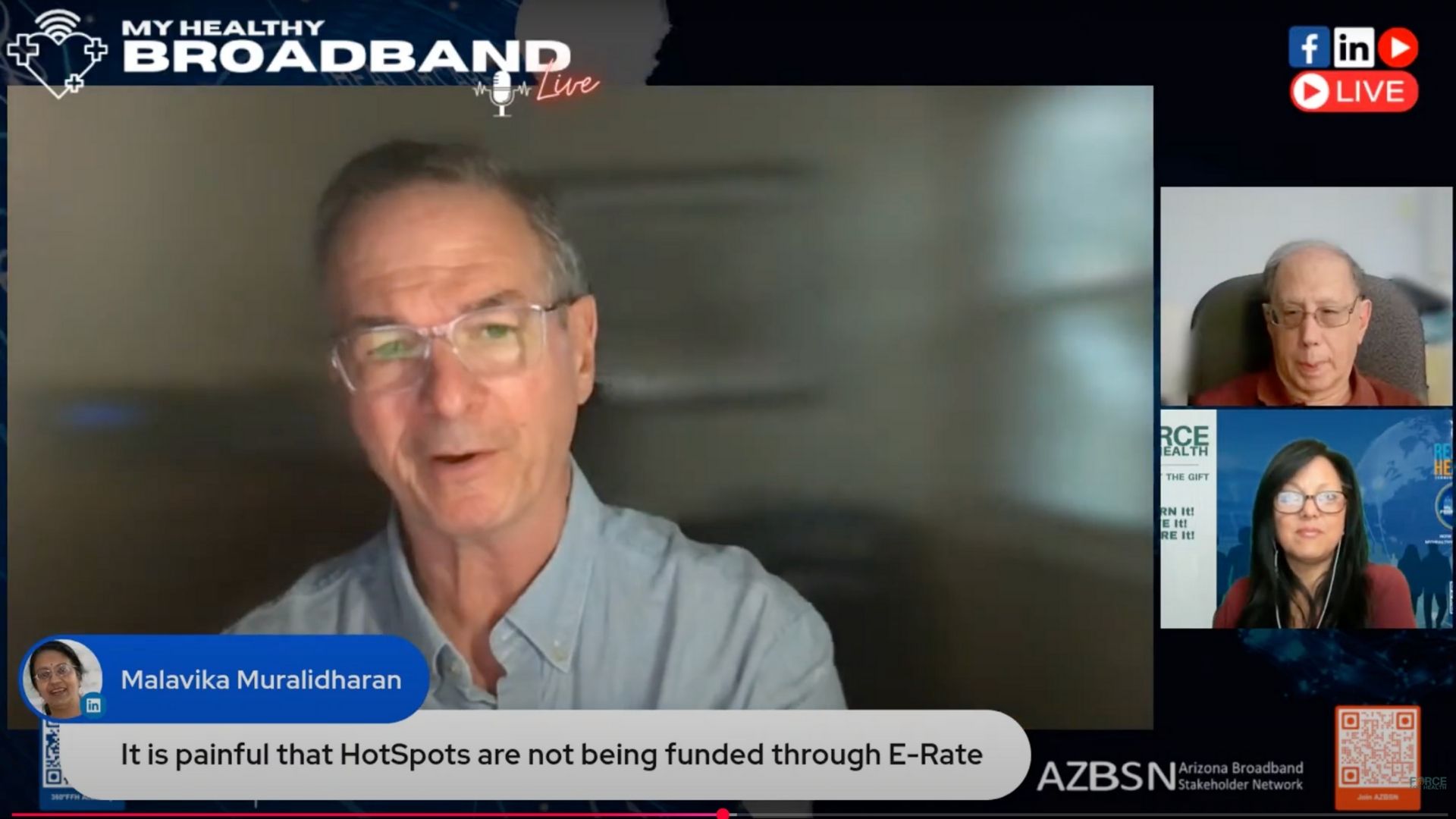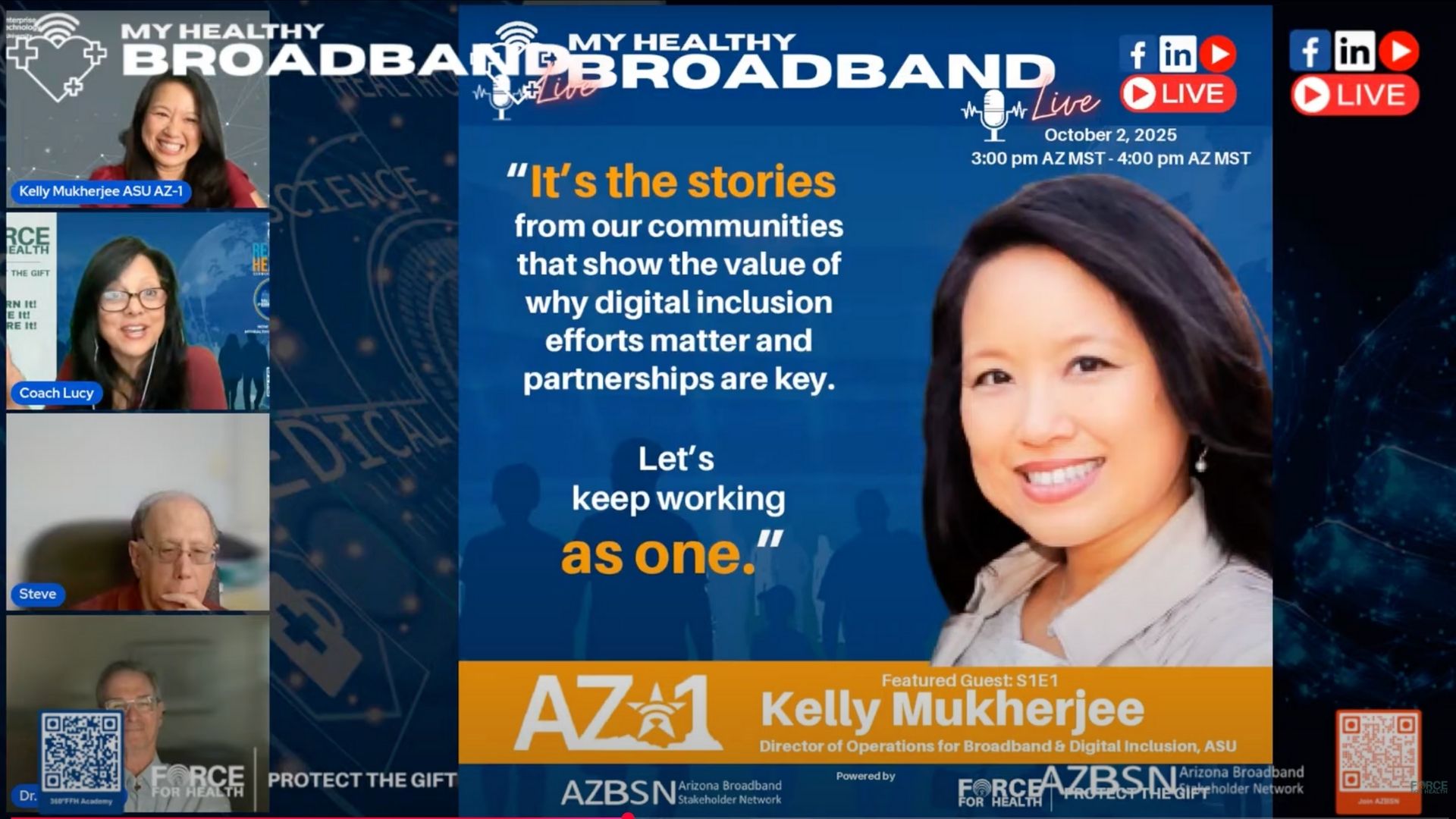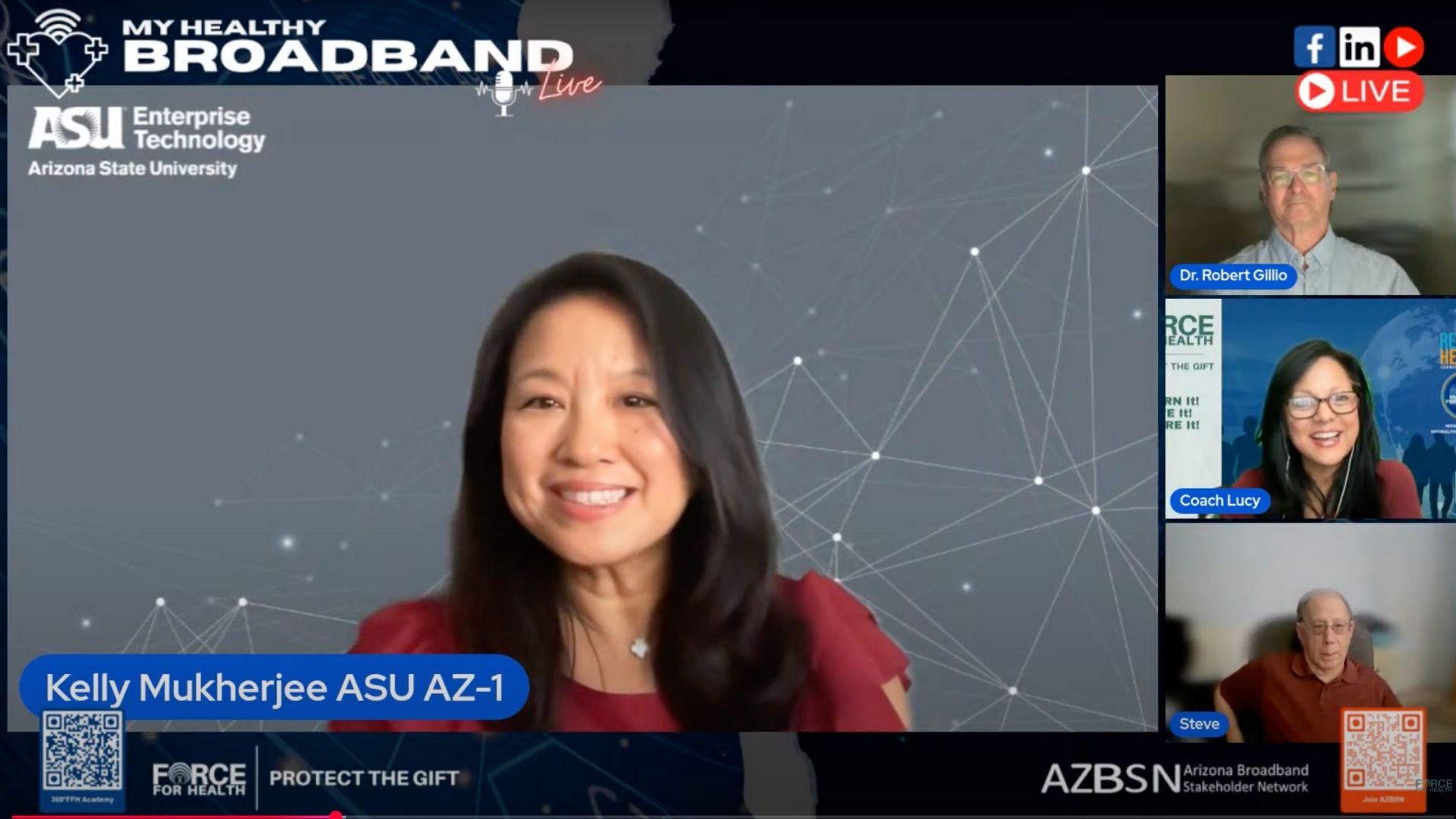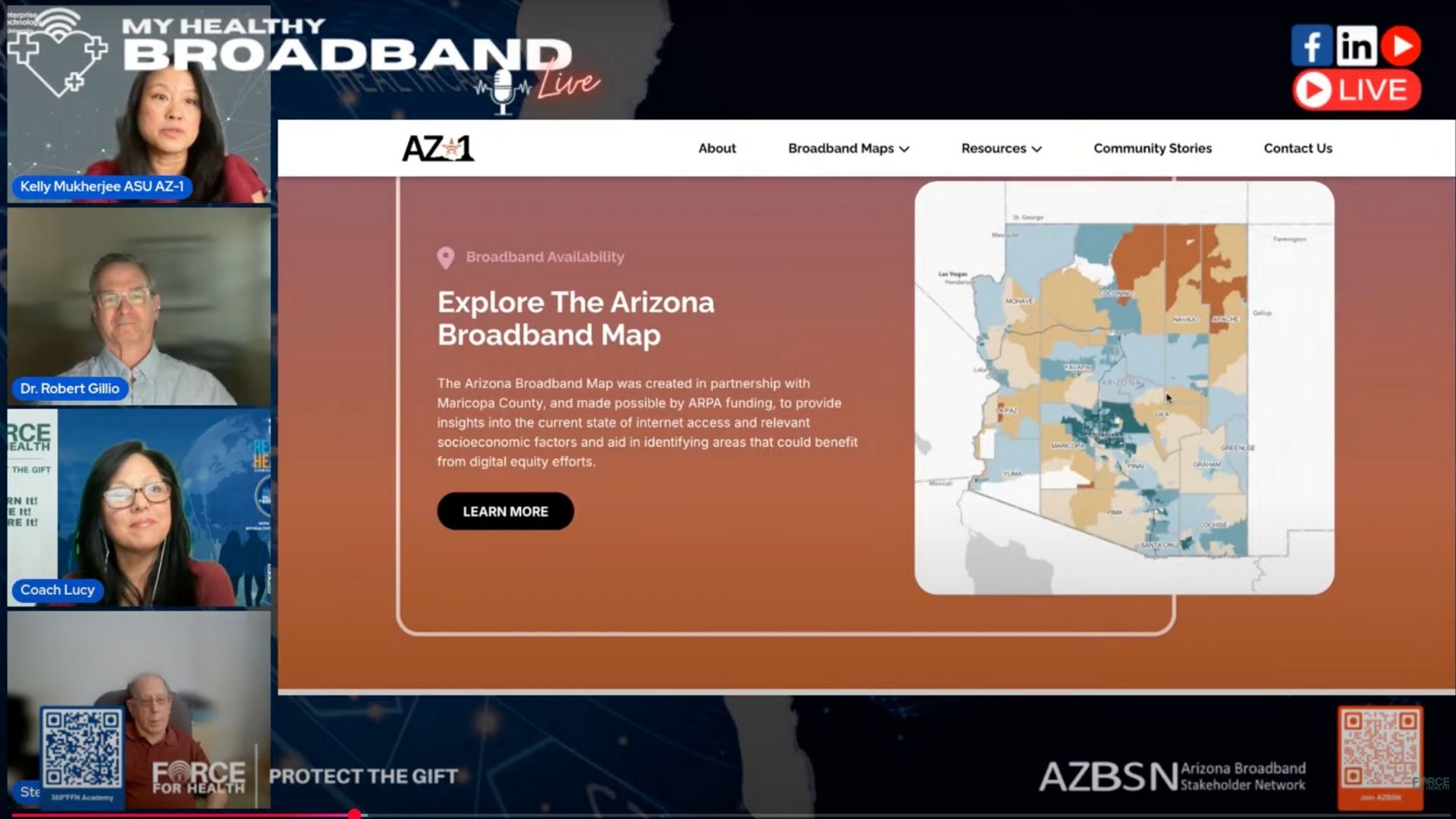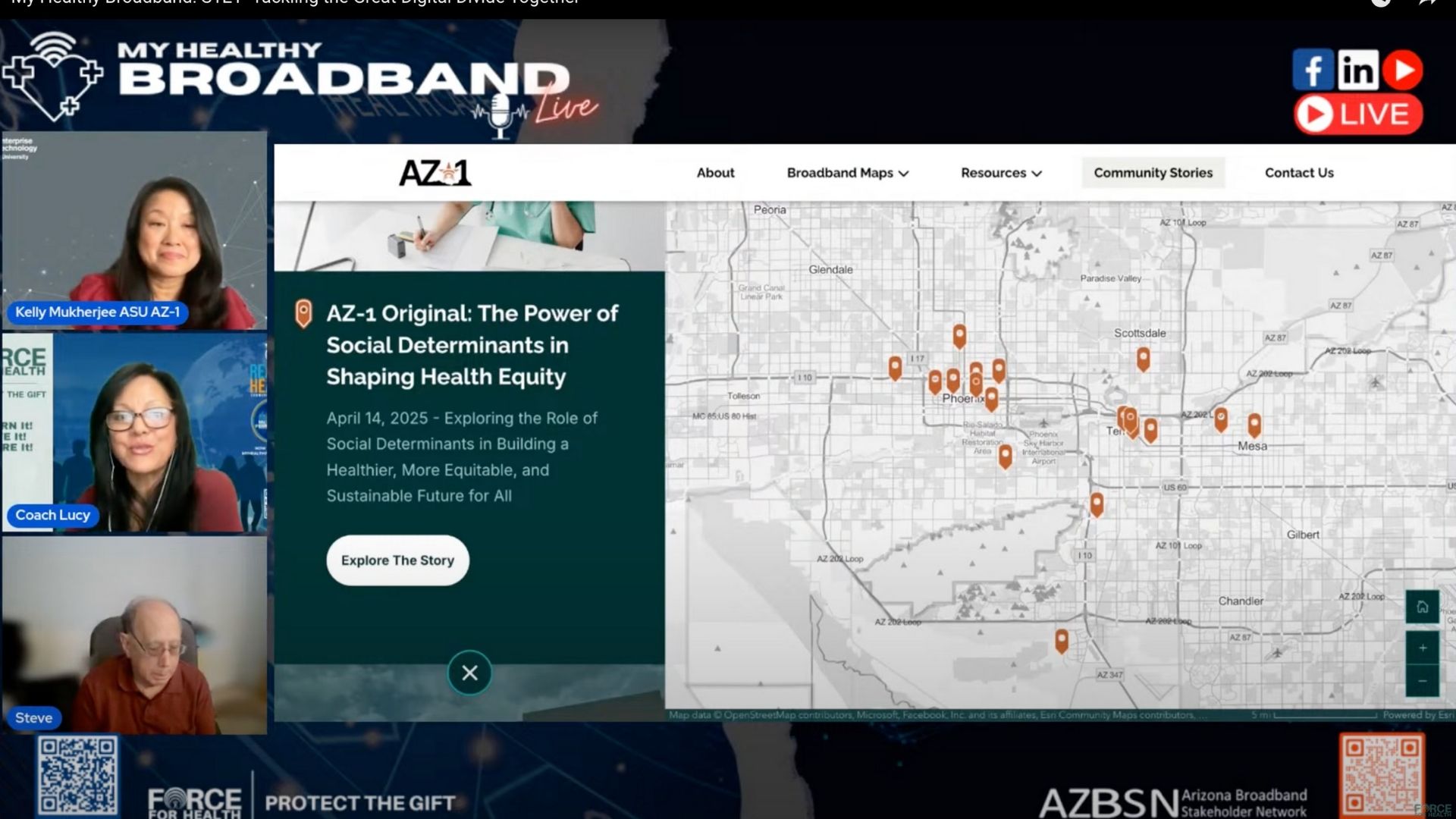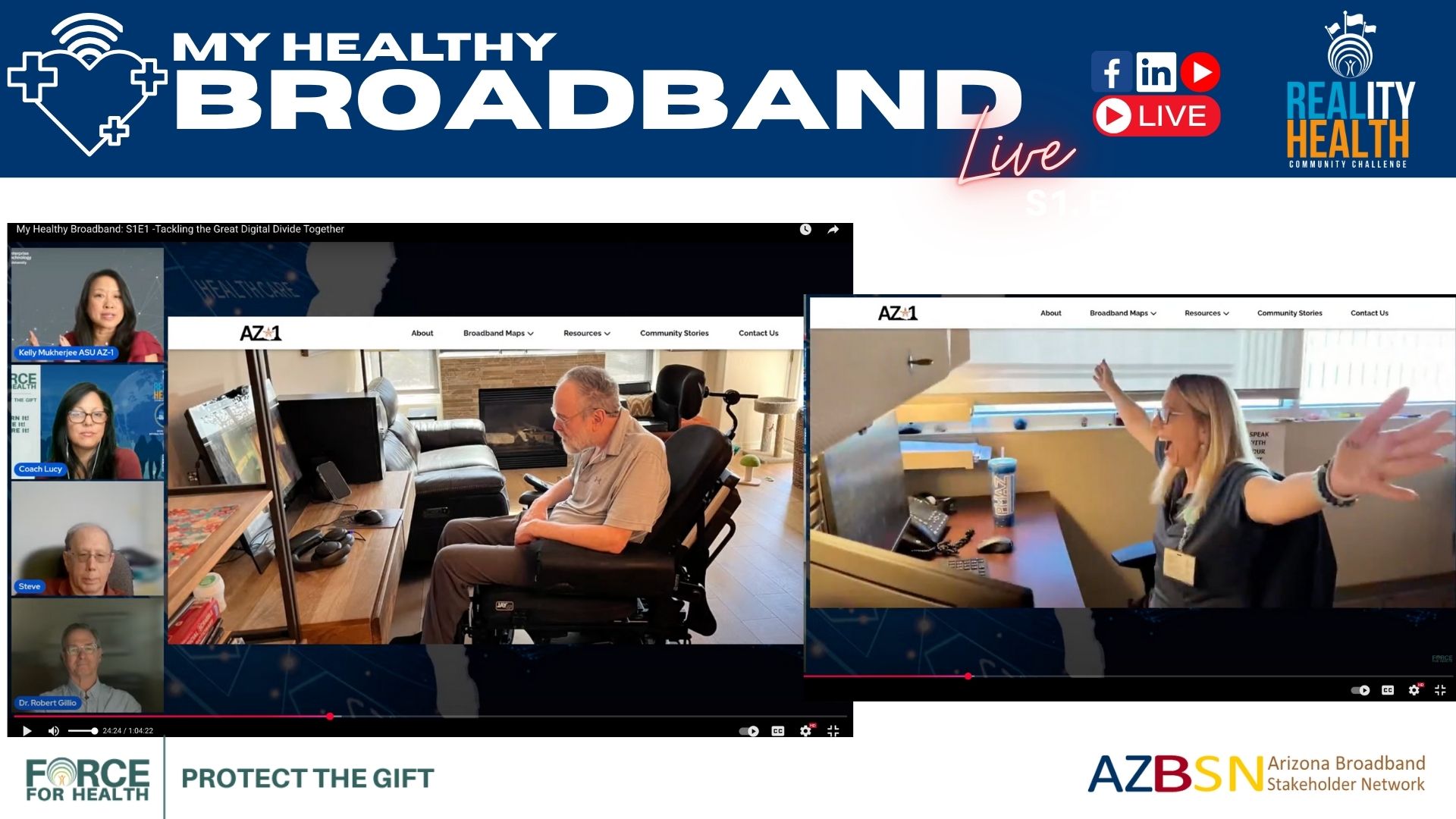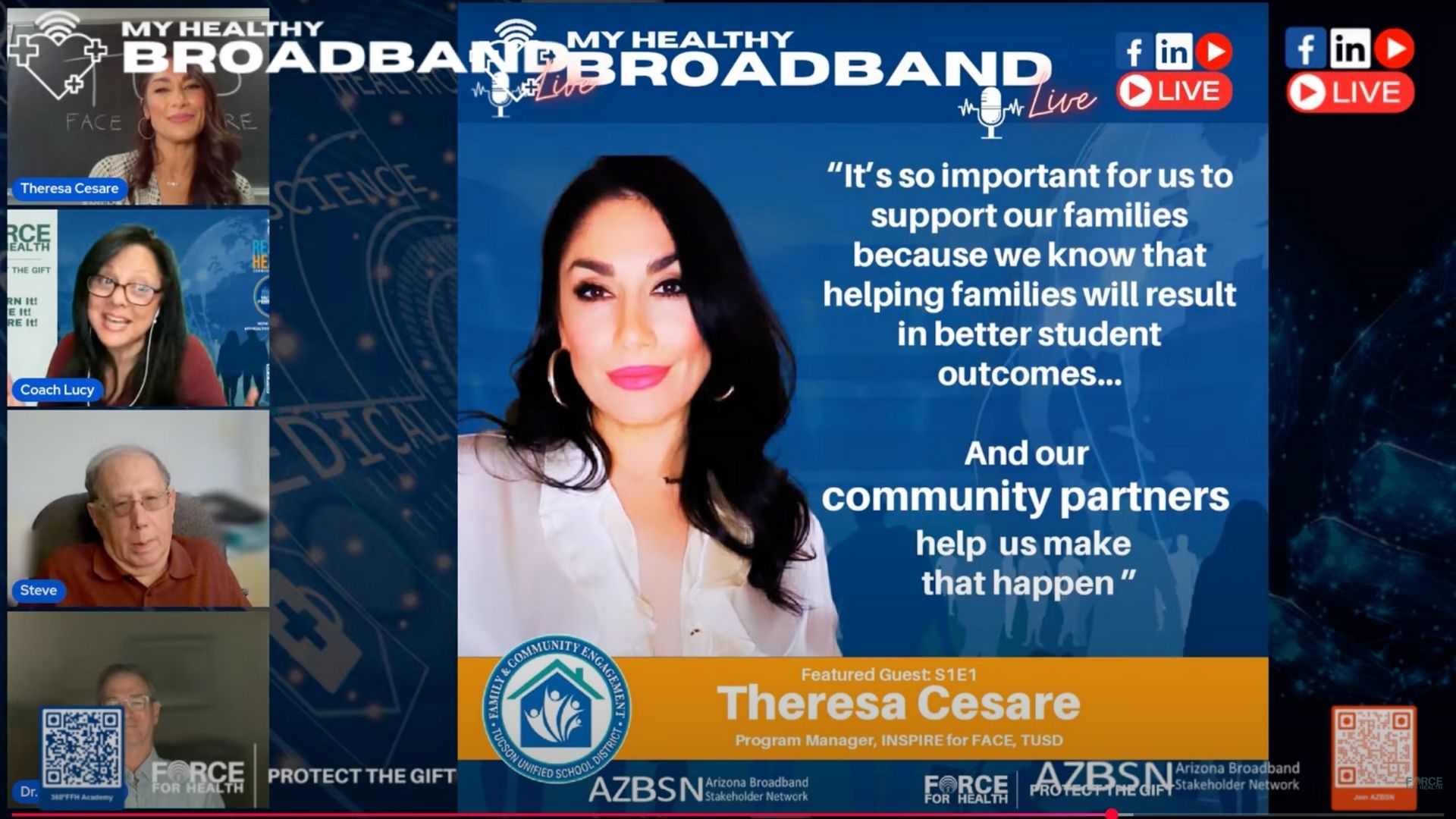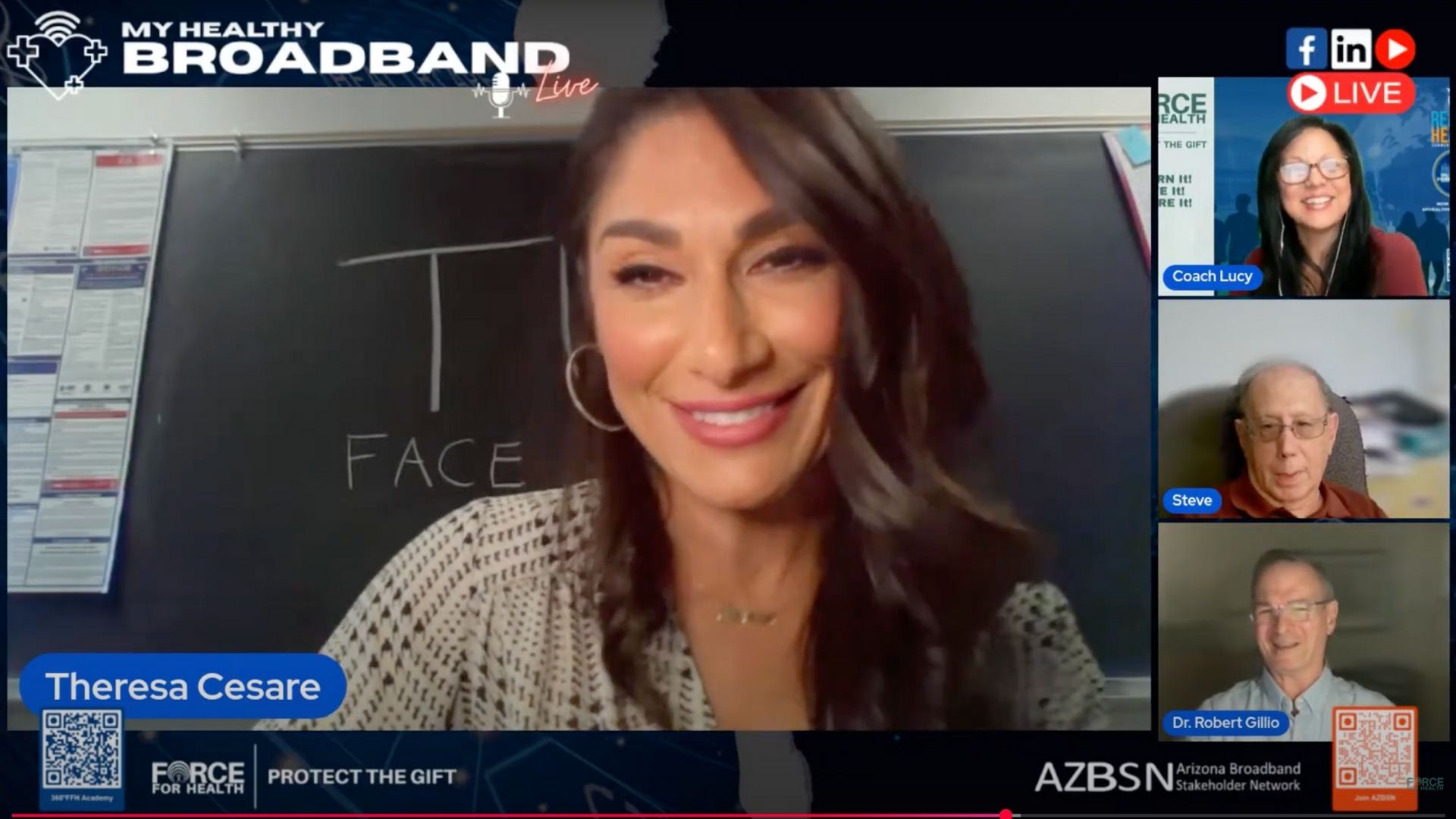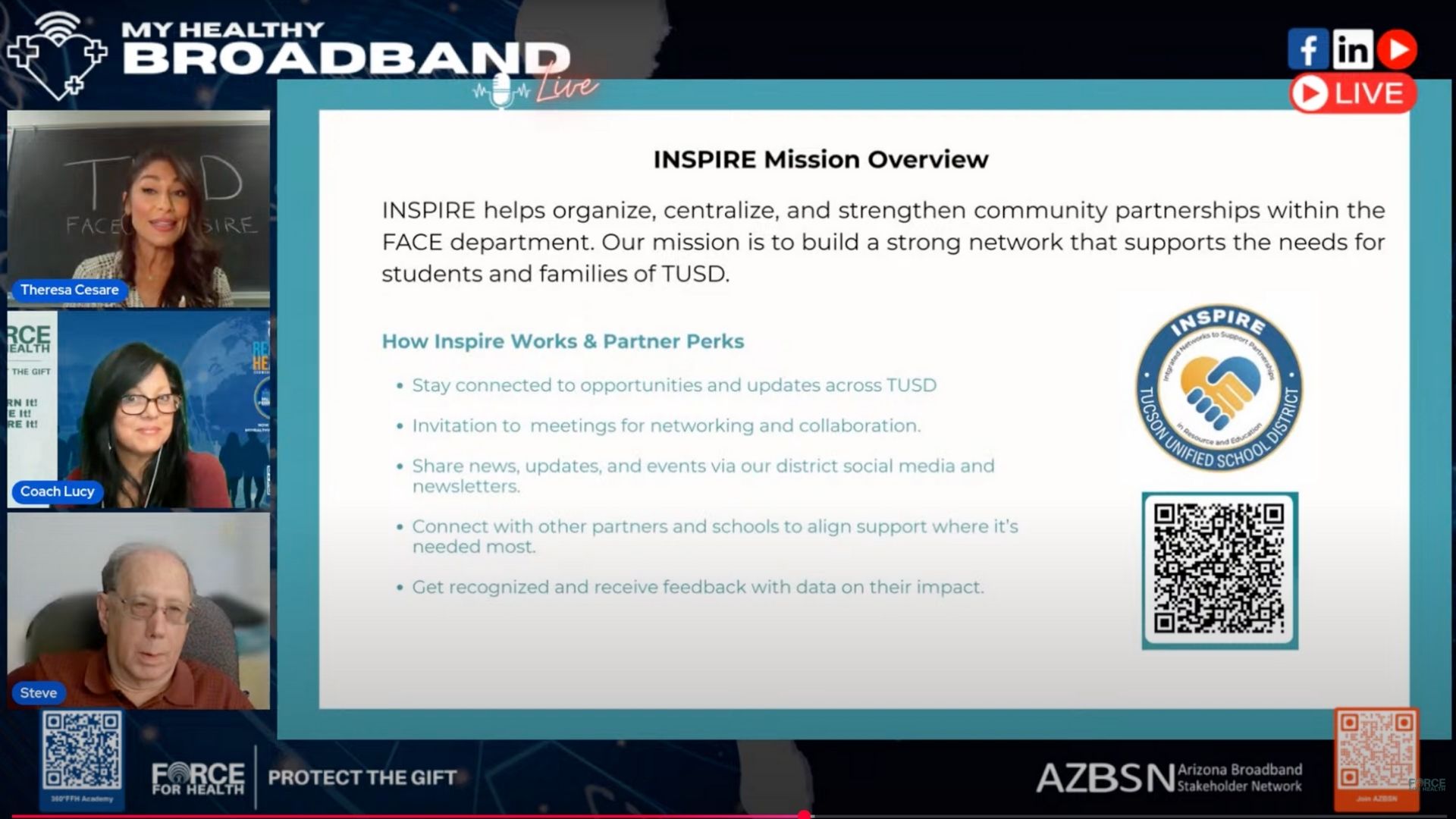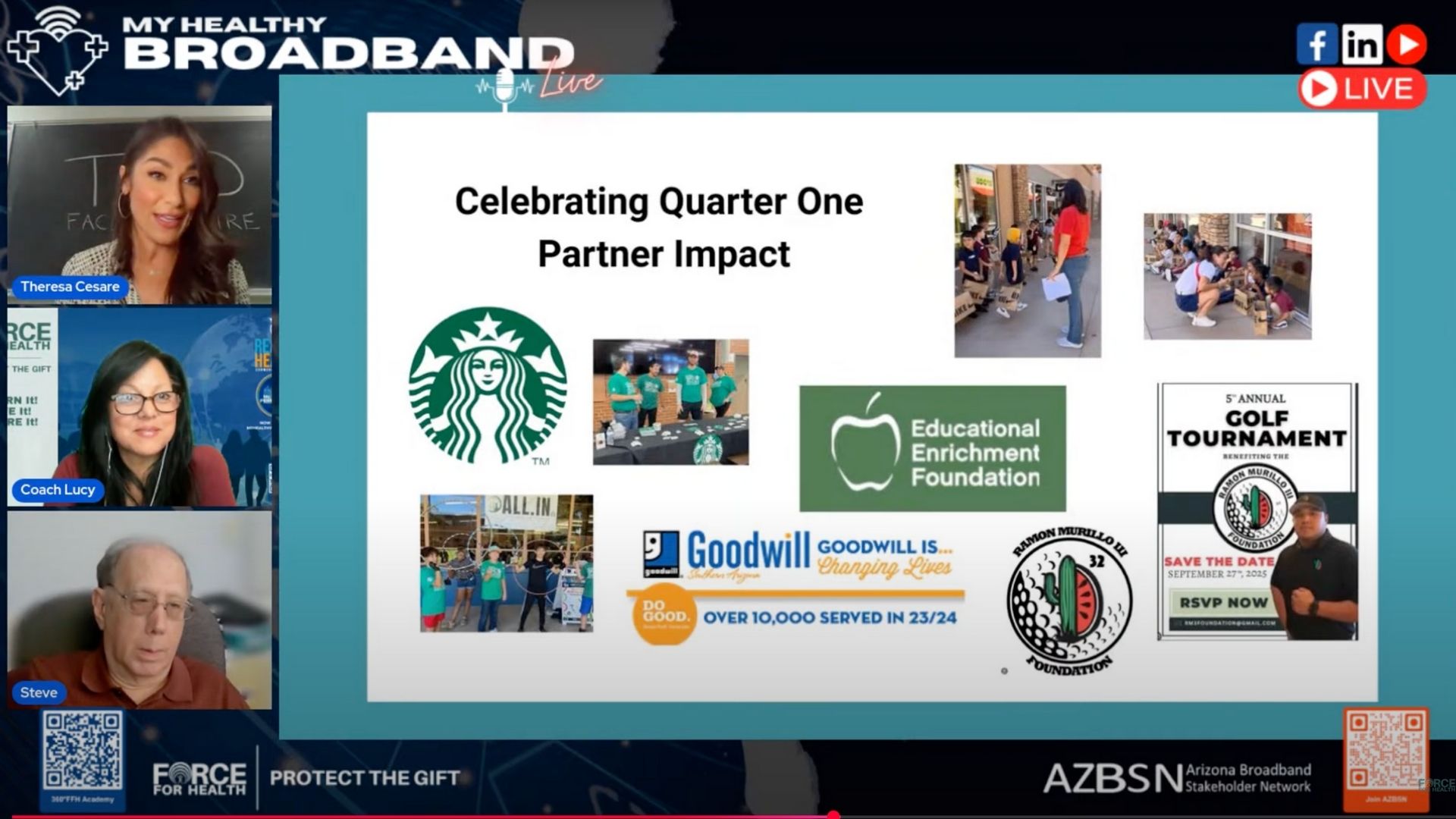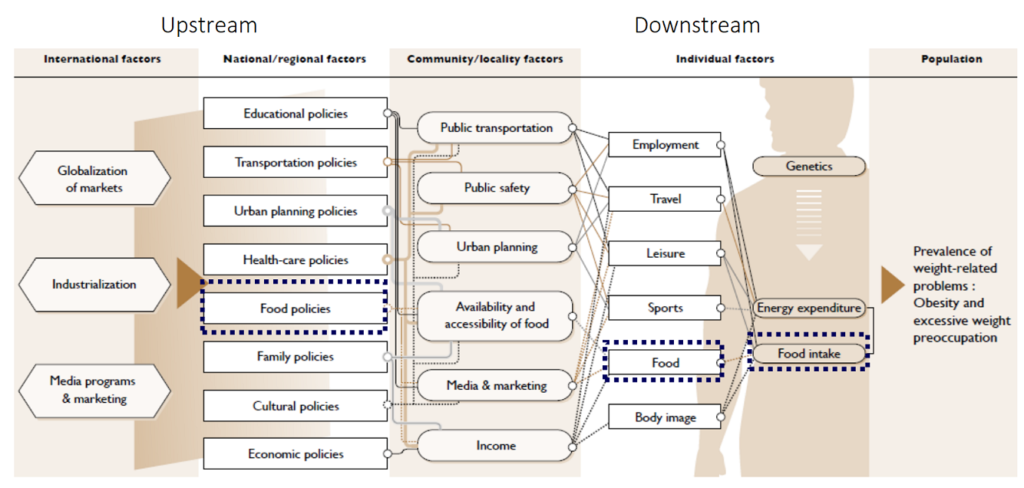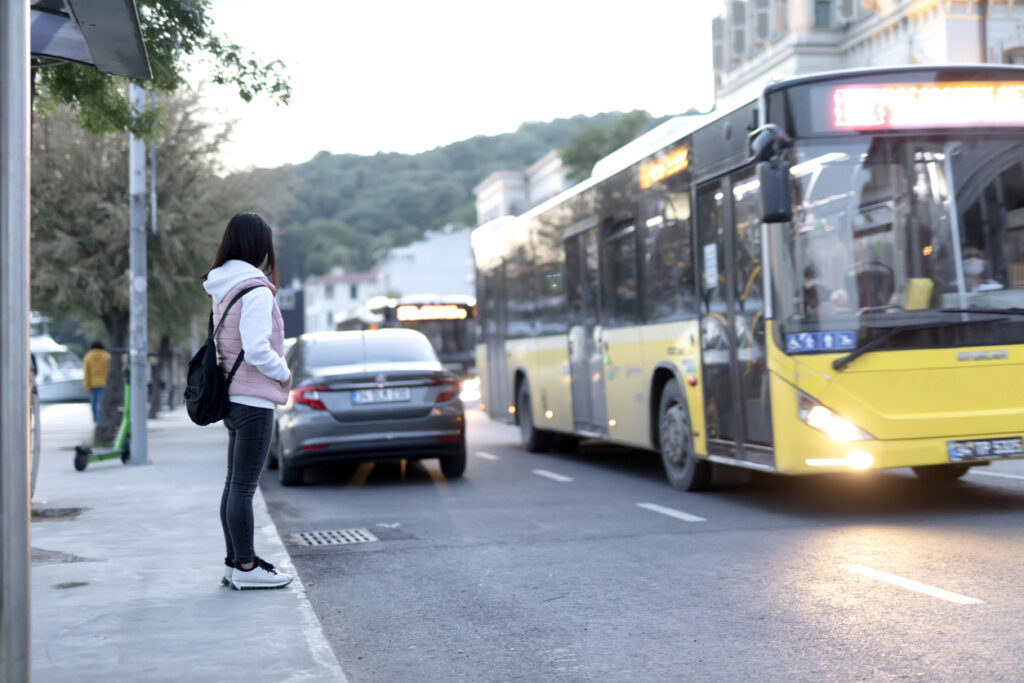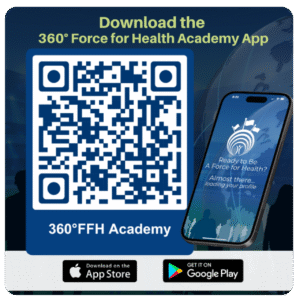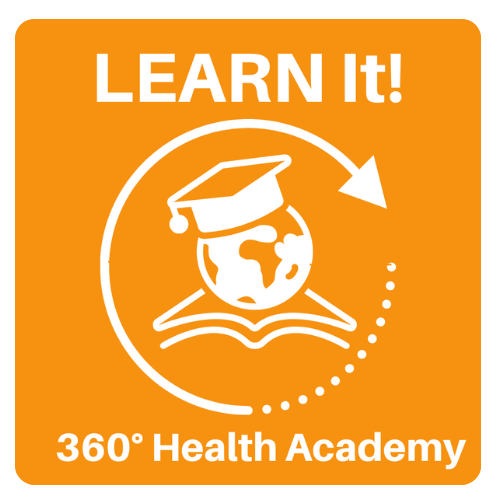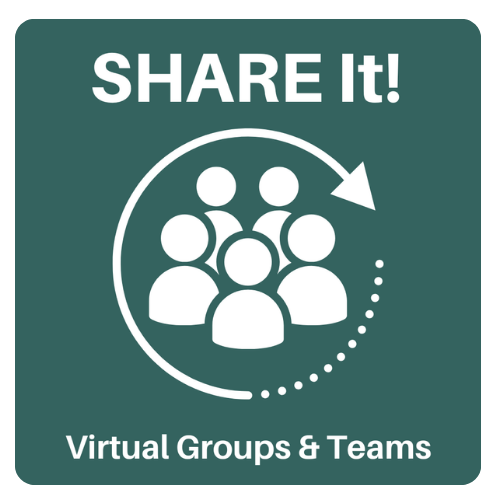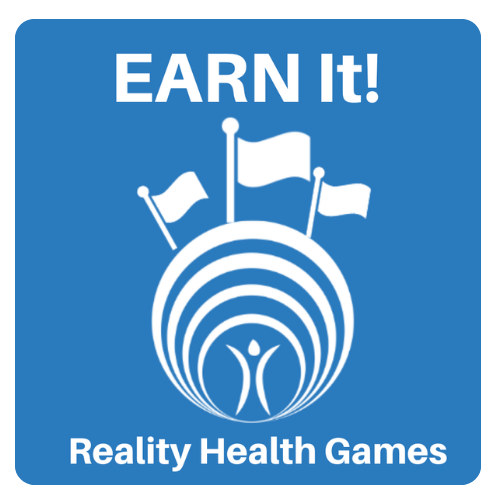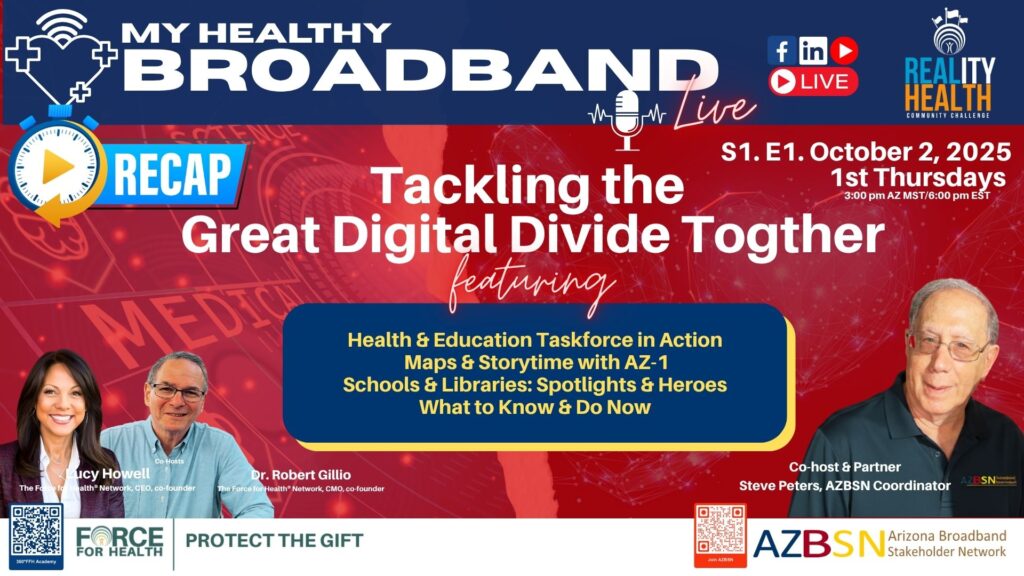
My Healthy Broadband LIVE Post Show Recap: S1.E1. – Tackling the Digital Divide, Together
Access to affordable, reliable broadband has become a non-negotiable need for communities to thrive. Whether it’s scheduling a doctor’s appointment, accessing homework assignments, applying for jobs, or staying socially connected, broadband access is now a core building block of health, education, and economic stability.
Recognizing this, the Arizona Broadband Stakeholders Network (AZBSN) Health & Education Task Force recently helped launch a new initiative: a monthly public broadcast called My Healthy Broadband. This effort brings together community leaders, technologists, healthcare professionals, and educators to highlight both the urgent challenges and inspiring solutions emerging across Arizona and beyond.
This first episode served as a public-facing outcome of the Task Force’s ongoing bi-weekly meetings, which began in April 2025, and are now evolving into actionable community engagement efforts.
🌐 From Collaboration to Conversation: A Community-Driven Broadcast
The broadcast opened with hosts Lucy Howell (Force for Health® Network), Dr. Robert Gillio, and Steve Peters (AZBSN) welcoming viewers and setting the stage for this new platform, born out of long-standing collaboration.
Steve Peters, a 25-year champion for broadband inclusion in Arizona, emphasized how the state has long been active in this work — despite public perception otherwise.
“People kept saying ‘nothing is happening in Arizona,’” Peters said. “But we knew otherwise. We started meeting weekly to share updates, build partnerships, and push progress forward — and now we’re bringing those conversations to Main Street.”
Lucy Howell clarified that the My Healthy Broadband show was not the launch of the Task Force, but rather one of its first public action items, aimed at making these issues more relatable for families, schools, and community leaders.
🏥 Broadband as a Super Determinant of Health
Retired pulmonologist and health equity advocate Dr. Robert Gillio spoke about the direct health consequences of broadband inaccessibility. Having testified before both state and federal legislatures, Dr. Gillio underscored how lack of connectivity in rural and low-income communities perpetuates systemic health disparities.
“Broadband is as essential today as electrification was in the 1930s,” he stated. “And not just in rural areas — underserved urban neighborhoods are also being bypassed by providers, creating digital deserts.”
These connectivity gaps make it harder for people to access healthcare, manage chronic conditions, or even find transportation or food resources. Gillio called for a mindset shift, treating broadband as a public utility, not a luxury.
🗺️ Mapping Impact Through Stories: ASU’s “As One” Platform
Kelly Mukherjee, Director of Operations at ASU Enterprise Technology, introduced the AZ-1 (pronounced As One) platform, an interactive mapping tool that merges broadband infrastructure data with community-submitted impact stories. Supported by a $34.6 million investment from Maricopa County, the platform is designed to empower communities and guide policy.
Mukherjee emphasized that broadband is a “super determinant” of health, enabling access to healthcare, education, employment, and civic engagement.
She shared the story of Mr. Mossberger, an Arizona man with Parkinson’s who now receives speech and physical therapy from home via Zoom — thanks to broadband access and a basic computer.
“He didn’t need a brand-new machine,” Dr. Gillio added. “He just needed to be connected.”
The AZ-1 platform includes stories like these across the state and invites the public to contribute their own experiences — demonstrating how broadband access has changed lives.
“The stories speak the loudest,” Mukherjee said. “They are what policymakers remember.”
💬 Community Voices: Comments from Arizona’s eRate Director
Live Chat Highlights | Throughout the Broadcast
Audience members actively engaged throughout the broadcast, with several weighing in via the interactive chat. One particularly important voice was Malavika Muralidharan, E-rate Administrator for Public Libraries, Arizona State Library, who highlighted urgent policy concerns:
“It’s painful that hotspots are not being funded through E-rate,” she noted. “This is exactly the type of issue that needs more visibility.”
Her comment sparked a larger discussion around stopgap solutions — such as enabling smartphones to serve as temporary hotspots — and further emphasized the need for sustainable funding models that prioritize digital access.
“Until the funding catches up, we must work with what we have,” Dr. Gillio responded. “And we must continue pressing for change.”
👨👩👧👦 School-Led Solutions: The TUSD INSPIRE Network
Teresa Caesar, Program Manager for Family and Community Engagement (FACE) at Tucson Unified School District (TUSD), shared how the district is building stronger community infrastructure through its INSPIRE Network — short for Integrating Networks to Support Partnerships in Resources and Education.
The INSPIRE model functions like a digital broadband network for families, linking them to wraparound services: food access, mental health support, transportation, clothing, digital devices, and more.
“We meet families where they are,” Caesar explained. “Just like broadband connects people seamlessly, so do we.”
Recent initiatives include:
- A partnership with Starbucks that provided 40 laptops to students
- A collaboration with the Murillo Foundation, supplying entire schools with sneakers
- Monthly community fairs that combine school services with health screenings and digital literacy resources
“It’s like being in the Oprah audience,” Caesar joked. “You get a laptop, you get shoes — and you walk out with real support.”
📣 Looking Ahead: Digital Inclusion Week
The episode concluded with a preview of Digital Inclusion Week, taking place October 7–11, 2025. This national event aims to raise awareness about digital equity and provide communities with tools, inspiration, and momentum to get involved.
The hosts shared several ways for viewers to take action during Digital Inclusion Week:
✅ Submit a digital equity story to the As One platform
✅ Check the map to find community assets in their area
✅ Host or attend a DIW event in their region
✅ Join AZBSN’s Health & Education Task Force for continued updates
✅ Teach a family member or neighbor how to access a device or use a new digital tool
“Even leading your family is leadership,” one host noted. “That’s where inclusion starts — in homes, neighborhoods, and schools.”
🔗 Conclusion: Action Starts Here
The debut of My Healthy Broadband marks a powerful shift — from behind-the-scenes task force strategy to main street conversation and activation.
By elevating stories, mapping assets, showcasing school and community leaders, and engaging the public, the show reflects a growing realization: broadband access is essential to individual and community well-being — and equity won’t happen without collective action.
As the AZBSN Health & Education Task Force continues to evolve, this broadcast will serve as a regular opportunity to educate, elevate, and empower.
“Let’s keep working together – As One. (thanks, AZ-1)”
✅ Get Involved:
- 🗺 Explore the AZ-1 (pronounces As One) Map & Resources and add your story at the bottom of the contact page
- 🗓 Join the AZBSN Health & Education Task Force powered by the Force for Health® Network
- 📆 Mark your calendar for Digital Inclusion Week: October 7–11, 2025
- 💻 Subscribe to the My Healthy Broadband YouTube channel
- 🗣 Share this article or forward it to a community leader
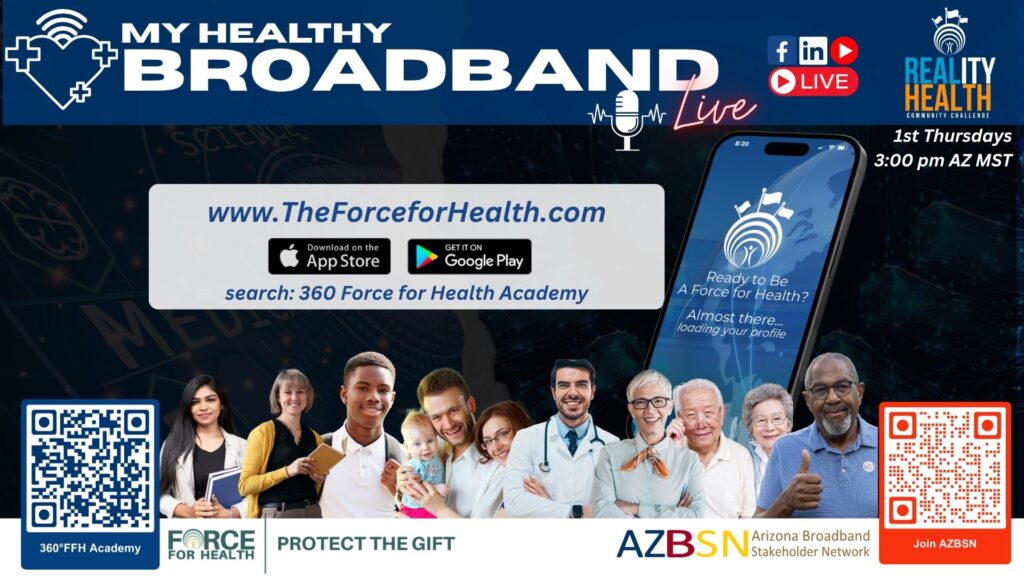
Come join our next Health & Education Taskforce on October, 9, 2025 at 3:00 pm
